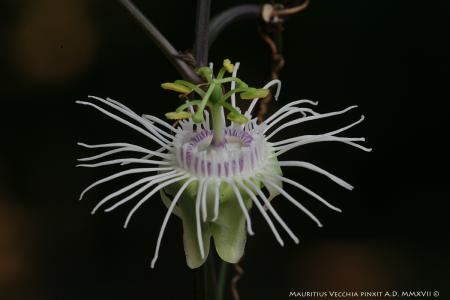
SUBGENUS: decaloba
SUPERSECTION: decaloba
SECTION: decaloba
GEOGRAPHICAL DISTRIBUTION OR ORIGIN:
Amazon basin of Peru and Bolivia up to Brazil and eastern Paraguay.
MINIMUM TEMPERATURE: 8 °C
IDEAL MINIMUM TEMPERATURE: 12 °C
ETYMOLOGY: From the Latin cuspis, cusp, tip. This species has leaves ending with three tips.
NOTES: Chromosomes: 2n=12
DESCRIPTION:
The silhouette of this passionflower's leaves calls to mind the footprints left by birds on the sand. In this regard, they have three narrow, long lobes with a pointed apex.
Others are completely different, having a central lobe longer than the lateral ones just mentioned. Often the leaf's surface is decorated with yellow, pink or dark red spots, similar to those present on the leaves of P. trifasciata, although less flamboyant. In other cases, they are uniform, of a very dark green, almost black colour. It is in fact a very variable species of which a number of varieties have already been identified and classified, such as P. tricuspis var. minor and P. tricuspis var. brevifolia.
It is a very decorative plant due to its variegated foliage and curious shape. It must be grown in pots, as its hardiness is limited by a minimum tolerated winter temperature of 10°C. It lends itself to being a houseplant, due to its remarkable ability to adapt. It is easy to grow and can be kept at a small size. It is also generous in flowering, which it does incessantly throughout the vegetative growth period. Just as abundantly, it continuously produces fruits of a beautiful glossy black, as big as olives.
Its leaves are on average up to 12 cm long and about half as wide.
The flowers, with a diameter of about 4-5 cm, are made up of large, short white sepals and petals. Above them lies the corona, also white or ivory, pink at the base. The filaments, arranged in two series, are sparse and robust.
It is
native to the Brazilian Amazon, Peru, Bolivia and Paraguay, where it is found
up to an altitude of about 1000 m.